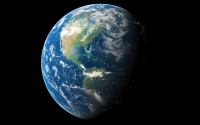26 March 2006Ned Potter
It was the summer of 1988, and strange things were happening: Repeated heat waves hit the eastern seaboard of the United States, while the Midwest was mired in massive drought. In some places, the waters of the Mississippi were so low that barges were stranded.
Were these phenomena related? It was hard for scientists to say, but on one sweltering Washington morning, a Senate subcommittee called for testimony from a prominent climatologist named James Hansen.
" Earth is warmer in 1988 than at any time in the history of instrumental measurements," said Hansen, director of NASA's Goddard Institute for Space Studies in New York, in his testimony before the subcommittee. He would later say, "The warming of a few degrees is going to take us to a world that is perhaps as different from today as the last ice age is from today."
Hansen set a fire as hot as the summer sun. Many fellow scientists said privately they were glad he had gone public, but they were not prepared to join him. Others doubted that these were "greenhouse signals" that could be separated from the ups and downs of the world's weather.
In the years since, many of them have changed their minds.
"I used to think part of the changes we were seeing in the Atlantic were cyclical," says Kerry Emanuel of MIT, "but several of my colleagues and I have worked very carefully on the data."
Emanuel published a paper in the journal Nature last summer, reporting that as average global temperatures rose in the last half-century, the intensity of Atlantic hurricanes had risen too.
"The hurricanes are following the tropical ocean temperature. The tropical ocean temperature is following the Northern Hemisphere. And it's very hard now to believe that there's anything natural about that," Emanuel says.
(A quick reminder of climate-change theory: Scientists like Hansen and Emanuel believe that gases such as carbon dioxide, created in part by our burning of coal and oil, trap the sun's heat in the atmosphere. Much of this happens naturally, but the concentration of carbon dioxide has increased dramatically since the beginning of the Industrial Revolution.)
No Turning Back?
Hansen, still at NASA, now warns that a deadline of sorts is approaching: In the next 20 years or so, he says, greenhouse warming may cause enough changes that, even if everyone stopped burning fossil fuels that release carbon dioxide into the atmosphere, some processes would have been set in motion that would continue anyhow.
"If we pass a certain point of no return that we're going to get large sea level rise, we will have started a process that we just can't stop," he says.
Scientists refer to these processes as "positive feedbacks," even though they regard the effects as negative.
A prime example: decayed vegetation in the Arctic, which contains massive amounts of carbon, used to be protected by the perpetual cold. As the climate warms — sped along by human beings burning fossil fuels that release carbon dioxide — scientists say the vegetation will dry out and break down, releasing even more carbon dioxide.
That carbon escaping into the atmosphere would cause more greenhouse warming.
"I feel very uncomfortable about it. I mean, it's not the way the Arctic should be," says Walter Oechel, a biologist from San Diego State University, as he stood on the tundra of Alaska's North Slope with ABC News' Bill Blakemore.
"Humans are putting about 6 [billion] or 7 billion metric tons of carbon in the atmosphere a year, and we're standing on 200 billion tons here," says Oechel. "Any significant portion comes out, that's worse than current human injection into the atmosphere. And once that runaway release occurs, there would be no way to stop it."
Solutions
Of course, scientists, politicians and advocates say they hope new technologies and better ways of using energy will make a major difference.
So-called renewable energy sources, which don't burn coal or oil, are a small part of the world's energy diet, but some, such as wind power, are growing in the United States at a rate of 20 percent a year.
Australian author and field biologist Tim Flannery, who describes himself as a former doubter of the climate-change problem, writes that if Americans invest in energy-efficient appliances when their current ones wear out, they could cut their energy use by as much as half.
Still, the scientists concede, some climate change may not be reversible.
"I think as far as environmental threats go over the next hundred years, it is the biggest threat that faces us," says Ronald Prinn of MIT, "and also the most difficult one to do something about."
http://abcnews.go.com/Technology/GlobalWarming/story?id=1765362&page=3






